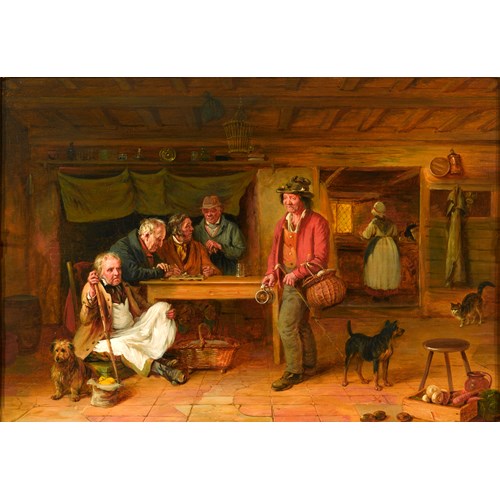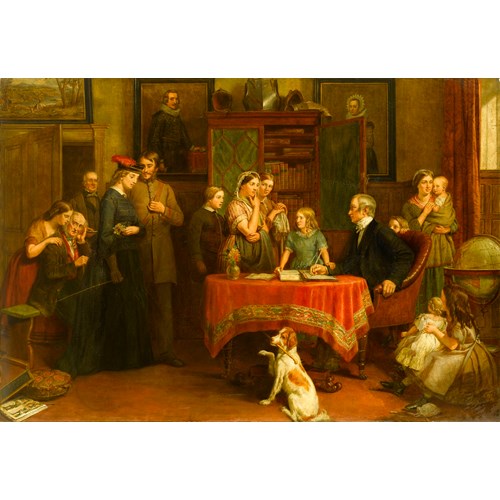Marketplace
A View of Šaukėnai, Lithuania
Mstislav Valerianovich Dobuzhinsky
A View of Šaukėnai, Lithuania
Epoque 20th century
Origine Russia, Lithuania
Medium Pencil on paper
Dimension 23 x 28 cm (9 x 11 inches)
A View of Šaukėnai, Lithuania depicts a rural alleyway surrounded by timber buildings full of character and charm. On the left and right side of the street, we see residential houses, ornamented with carvings in the traditional fashion. At the end of the street, a grand eighteenth century wooden synagogue rises up, its triple roofs dominating the scene, demonstrating the importance of the building to the local community.
Judaism in Lithuania has had a long and turbulent history; from the early Jewish migrants settling there in the eighth century, there followed cycles of prosperity and persecution, unrest and understanding. The Grand Duchy of Lithuania ceased to exist in 1795, having been invaded and partitioned between the Russian and Habsburg Empires, and the Kingdom of Prussia. By the end of the nineteenth century, many Jews fled the Russian Empire to escape the pogroms which were engulfing the region, 2,000,000 leaving for the United States, United Kingdom and elsewhere between 1880 and 1914. Lithuania regained its independence in 1918, where followed a period of fierce border disputes with Germany and Poland externally, and fervent anti-Semetism internally. In 1940, the Soviet Union annexed the country, only for Germany to invade a year later. Of the 200,000 Jews remaining in Lithuania, 90% were to die in the Holocaust.
Šaukėnai in 1940 was home to around 700 people, 40% of them Jewish. On 26th June, German forces occupied the town, and in the first few days of occupation, Lithuanians entered the synagogue during prayers and dragged the men off to forced labour units. On 28th July, all the remaining Jews were forced from their homes and confined to the synagogue, where they were relieved of their valuables. They were then marched to a farm in the nearby estate of Shukishok, along with other Jewish families from surrounding villages. On 30th July, 200 of the 330 men, women and children on the farm were marched into the nearby forest wearing just their underclothes, led to a large pit recently dug by local peasants. They were shot and buried in a mass grave. The survivors were divided into work groups in local farms, but in August 1941 were rounded up and led to the ghetto in Žagarė. None were to escape the infamous massacre of 2nd October.
The synagogue burnt down in 1944, by which time there were no Jews remaining in Šaukėnai. Today, with even the newest of the wooden synagogues nearing 100 years old, those that did survive have fallen into disrepair. With a lack of funds to sustain them, and very few Jews remaining in Lithuania, fewer than a dozen are estimated to remain.¹
Dobuzhinsky sought an artistic education in Europe before settling in St. Petersburg in 1901, joining Mir Iskusstva the following year, to become one of the youngest and most gifted members of the group. He soon became noted for his cityscapes conveying the explosive growth and decay of the early twentieth-century city and this particular subject matter as well as his expressive technique set him apart from other members of the movement. From 1907 he expanded his activities to encompass stage design, teaching and book illustration. His most significant foray into the latter was illustrating Fyodor Dostoevsky’s (1821-1881) White Nights, in which, as throughout his career, ‘Dobuzhinsky interpreted the city as the real hero of the story’.² In 1924 he left Russia for Lithuania and subsequently travelled throughout Europe before finally settling in the United States.
¹ www.jewishgen.org.
² Rosenfeld, A., ‘The World of Art Group: Book and Poster Design’ in Defining Russian Graphic Arts: from Diaghilev to Stalin, 1898-1934, ed. Rosenfeld, A. (Rutgers University Press, 1999) p.89.
Judaism in Lithuania has had a long and turbulent history; from the early Jewish migrants settling there in the eighth century, there followed cycles of prosperity and persecution, unrest and understanding. The Grand Duchy of Lithuania ceased to exist in 1795, having been invaded and partitioned between the Russian and Habsburg Empires, and the Kingdom of Prussia. By the end of the nineteenth century, many Jews fled the Russian Empire to escape the pogroms which were engulfing the region, 2,000,000 leaving for the United States, United Kingdom and elsewhere between 1880 and 1914. Lithuania regained its independence in 1918, where followed a period of fierce border disputes with Germany and Poland externally, and fervent anti-Semetism internally. In 1940, the Soviet Union annexed the country, only for Germany to invade a year later. Of the 200,000 Jews remaining in Lithuania, 90% were to die in the Holocaust.
Šaukėnai in 1940 was home to around 700 people, 40% of them Jewish. On 26th June, German forces occupied the town, and in the first few days of occupation, Lithuanians entered the synagogue during prayers and dragged the men off to forced labour units. On 28th July, all the remaining Jews were forced from their homes and confined to the synagogue, where they were relieved of their valuables. They were then marched to a farm in the nearby estate of Shukishok, along with other Jewish families from surrounding villages. On 30th July, 200 of the 330 men, women and children on the farm were marched into the nearby forest wearing just their underclothes, led to a large pit recently dug by local peasants. They were shot and buried in a mass grave. The survivors were divided into work groups in local farms, but in August 1941 were rounded up and led to the ghetto in Žagarė. None were to escape the infamous massacre of 2nd October.
The synagogue burnt down in 1944, by which time there were no Jews remaining in Šaukėnai. Today, with even the newest of the wooden synagogues nearing 100 years old, those that did survive have fallen into disrepair. With a lack of funds to sustain them, and very few Jews remaining in Lithuania, fewer than a dozen are estimated to remain.¹
Dobuzhinsky sought an artistic education in Europe before settling in St. Petersburg in 1901, joining Mir Iskusstva the following year, to become one of the youngest and most gifted members of the group. He soon became noted for his cityscapes conveying the explosive growth and decay of the early twentieth-century city and this particular subject matter as well as his expressive technique set him apart from other members of the movement. From 1907 he expanded his activities to encompass stage design, teaching and book illustration. His most significant foray into the latter was illustrating Fyodor Dostoevsky’s (1821-1881) White Nights, in which, as throughout his career, ‘Dobuzhinsky interpreted the city as the real hero of the story’.² In 1924 he left Russia for Lithuania and subsequently travelled throughout Europe before finally settling in the United States.
¹ www.jewishgen.org.
² Rosenfeld, A., ‘The World of Art Group: Book and Poster Design’ in Defining Russian Graphic Arts: from Diaghilev to Stalin, 1898-1934, ed. Rosenfeld, A. (Rutgers University Press, 1999) p.89.
Epoque: 20th century
Origine: Russia, Lithuania
Medium: Pencil on paper
Signature: Signed, inscribed and indistinctly dated 'MDobuzhinsky / 3* / Saukenai' (lower right).
Dimension: 23 x 28 cm (9 x 11 inches)
Provenance: Ben Uri Art Gallery
Plus d'œuvres d'art de la Galerie









